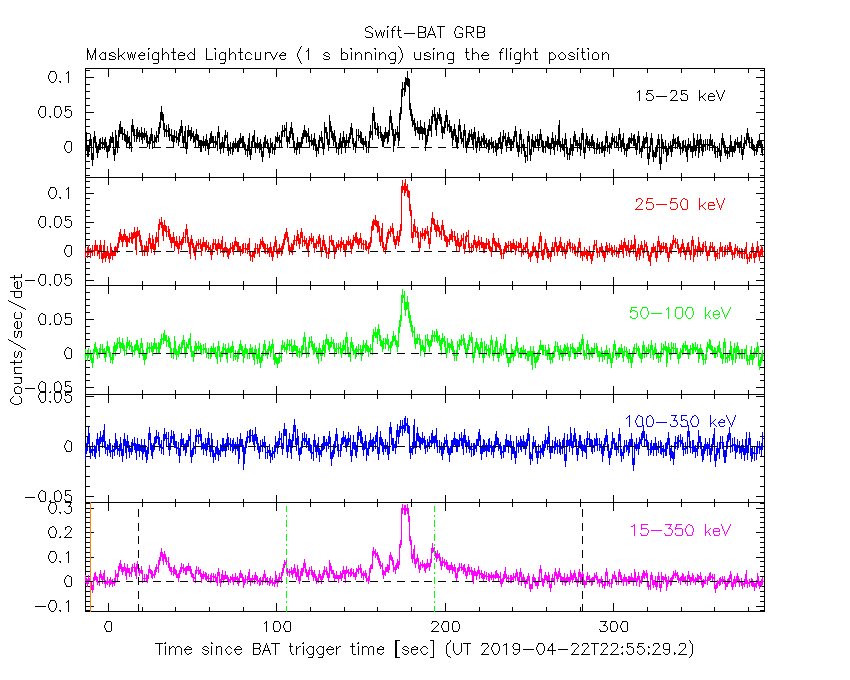
M.J. Moss (George Washington University), D.N. Burrows (PSU) and K.K. Simpson (PSU) for the Swift team
At 22:55:29 UT, the Swift Burst Alert Telescope (BAT) triggered and located GRB 190422A (trigger=899979) (Moss et al. GCN Circ. 24147). Swift did not slew until ~T+8 min due to an observing constraint. At the time of the trigger, the initial BAT position was 128° from the Sun (10.1 hours East) and 65° from the 86%-illuminated Moon. Table 1 contains the best reported positions from Swift, and the latest XRT position can be viewed at http://www.swift.ac.uk/xrt_positions.
Table 2 is a summary of GCN Circulars about this GRB from observatories other than Swift.
Standard analysis products for this burst are available at https://gcn.gsfc.nasa.gov/swift_gnd_ana.html.
As reported by Sakamoto et al. (GCN Circ. 24157),
the BAT ground-calculated position is RA, Dec = 182.126, -60.167 deg which is RA(J2000) = 1
The mask-weighted light curve (Figure 1) shows a multi-peaked structure.
The emission started before the source entered the BAT FOV, and lasted until ~T+360 s.
The main peak occurred at ~ T+175 s.
We cannot determine
The time-averaged spectrum from T+6.39 to T+359.48 s is best fit by a simple power-law model.
The power law index of the time-averaged spectrum is 1.76 ± 0.08.
The fluence in the 15-150 keV band is 6.5 ± 0.3 x 1
The results of the batgrbproduct analysis are available at https://gcn.gsfc.nasa.gov/notices_s/899979/BA/.
Analysis of the initial XRT data was reported by Burrows et al. (GCN Circ. 24155). We have analysed 12 ks of XRT data for GRB 190422A, from 536 s to 65.4 ks after the BAT trigger. The data are entirely in Photon Counting (PC) mode. The enhanced XRT position for this burst was given by Evans et al. (GCN Circ. 24151).
The light curve (Figure 2) can be modelled with a series of power-law decays. The initial decay index is α=3.8 (+1.1, -1.0). At T+839 s the decay flattens to an α of -0.05 (+0.08, -0.57) before breaking again at T+9484 s to a final decay with index α=0.92 ± 0.10.
A spectrum formed from the PC mode data can be fitted with an absorbed power-law with a photon spectral index of 2.05 (+0.15, -0.14). The best-fitting absorption column is 1.69 (+0.21, -0.19) x 1
A summary of the PC-mode spectrum is thus:
Total column: 1.69 (+0.21, -0.19) x 1
Galactic foreground: 8.6 x 1
Excess significance: 7.0 σ
Photon index: 2.05 (+0.15, -0.14)
The results of the XRT team automatic analysis are available at http://www.swift.ac.uk/xrt_products/00899979.
The Swift/UVOT began settled observations of the field of GRB 190422A 532 s after the BAT trigger
(Simpson and Moss GCN Circ. 24159).
No optical afterglow consistent with the XRT position (Evans et al. GCN Circ. 24151) is detected in the initial UVOT exposures.
Table 3 gives preliminary
magnitudes using the UVOT photometric system
(Breeveld et al. 2011, AIP Conf. Proc., 1358, 373).
No correction has been made for the expected extinction in the Milky Way
corresponding to a reddening of

Figure 1. The BAT
mask-weighted light curve in the four individual and total
energy bands. The units are counts

Figure 2. The XRT light curve.
Any data from a crosshatched region are not included in the fit.
| RA (J2000) | Dec (J2000) | Error | Note | Reference |
|---|---|---|---|---|
| 1 |
-60°13'27.6" | 1.4" | XRT-final | UKSSDC |
| 1 |
-60°13'27.3" | 1.8" | XRT-enhanced | Evans et al. GCN Circ. 24151 |
| 1 |
-60°10'02.6" | 2.4' | BAT-refined | Sakamoto et al. GCN Circ. 24157 |
| Band | Authors | GCN Circ. | Subject | Observatory | Notes |
|---|---|---|---|---|---|
| Optical | Lipunov et al. | 24148 | Fermi GRB190422.67 Global MASTER-Net observations report |
MASTER | |
| Optical | Lipunov et al. | 24150 | Swift GRB190422.96 Global MASTER-Net observations report |
MASTER | |
| Gamma-ray | Hamburg et al. | 24161 | Fermi GBM detection | Fermi GBM | Fluence=4.8±0.3x1 (5 |
| Filter | Exp(s) | Mag | ||
|---|---|---|---|---|
| whit |
532 | 682 | 147 | >18.8 |
| white | 532 | 7906 | 647 | >18.8 |
| v | 689 | 6879 | 352 | >17.2 |
| b | 788 | 7700 | 352 | >18.3 |
| u | 763 | 7495 | 352 | >18.9 |
| w1 | 738 | 7289 | 352 | >19.1 |
| m2 | 713 | 7084 | 352 | >19.1 |
| w2 | 838 | 7995 | 438 | >19.6 |
Table 3. UVOT observations reported by Simpson and Moss (GCN Circ. 24159). The start and stop times of the exposures are given in seconds since the BAT trigger. The preliminary 3-σ upper limits are given. No correction has been made for extinction in the Milky Way.
April 24, 2019